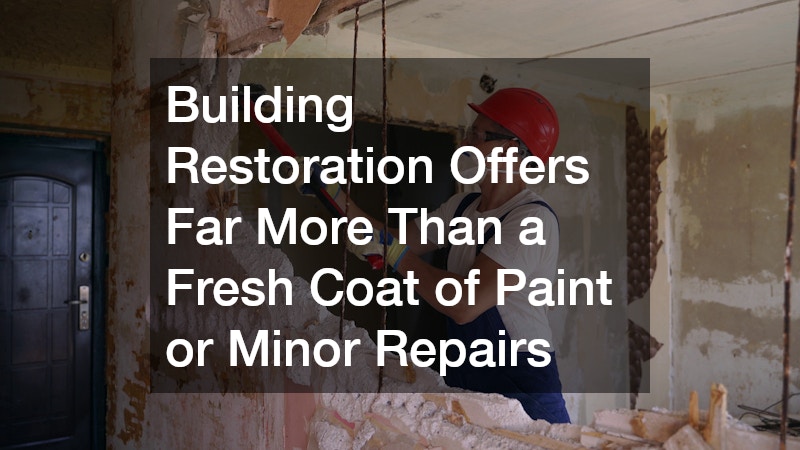Commercial properties are significant investments, often representing years of hard work and capital. Over time, however, even the best-maintained buildings can show signs of wear and tear. Aging infrastructure, outdated aesthetics, and evolving safety standards can all contribute to a property’s decline. Building restoration is an essential solution for property owners looking to maintain or enhance the value, safety, and visual appeal of their commercial assets. Unlike simple renovations or cosmetic updates, restoration involves a comprehensive approach that addresses both structural and aesthetic concerns, preserving the integrity of your building while modernizing its functionality. In this article, we’ll explore the benefits of building restoration, guide you through decisions regarding restoration versus renovation or demolition, and provide tips for selecting a qualified contractor to ensure your project succeeds.
What Are the Benefits of Building Restoration?
Building restoration offers far more than a fresh coat of paint or minor repairs. The process is designed to rejuvenate a property’s structure and appearance while also improving its long-term value and performance. Some of the key benefits include:
1. Enhanced Property Value
One of the most immediate advantages of building restoration is its impact on property value. Restored buildings often attract higher rental income and increased investor interest. Modernizing a commercial property while preserving its original character can make it more appealing to tenants, clients, and buyers, giving your investment a competitive edge in the real estate market.
2. Improved Energy Efficiency
Many older commercial buildings were constructed before energy efficiency standards became a priority. Building restoration can address insulation, windows, roofing, and HVAC systems, significantly reducing energy consumption and utility costs. Energy-efficient upgrades not only save money in the long run but can also make your property more attractive to environmentally conscious tenants.
3. Compliance With Safety Standards
Building codes and safety regulations are constantly evolving. A restoration project allows property owners to address potential safety hazards, such as outdated electrical systems, fire protection deficiencies, or structural weaknesses. Ensuring compliance not only protects occupants but also reduces the risk of costly legal or insurance issues in the future.
4. Preservation of Aesthetic Appeal
Beyond functional improvements, building restoration preserves and enhances the aesthetic appeal of your commercial property. Historical facades, unique architectural features, or distinctive interiors can be maintained or restored, providing a visually appealing space that stands out in the marketplace. A well-restored property can also reinforce brand image for businesses operating within the space.
How Do I Decide Between Restoration, Renovation, or Demolition?
Determining the best approach for your commercial property can be challenging. Each option—restoration, renovation, or demolition—serves different purposes, and the right choice depends on your goals, budget, and the condition of the building.
1. Restoration
Restoration focuses on returning a building to its former glory while maintaining structural integrity. It is ideal for properties with historical significance, unique architectural details, or a solid foundation that simply needs modernization. Restoration preserves original materials and design elements while upgrading the building to meet current safety and performance standards.
2. Renovation
Renovation typically involves updating, redesigning, or reconfiguring spaces without necessarily preserving original elements. Renovations are often suitable for buildings that need functional improvements, such as modern office layouts, upgraded technology infrastructure, or cosmetic enhancements. While renovation can be less expensive than full restoration, it may not preserve the building’s historical or architectural value.
3. Demolition
Demolition is generally considered when a building is structurally unsound, severely outdated, or no longer meets the needs of its intended use. While this option allows for a fresh start, it often involves higher long-term costs due to the need to construct a new building. Demolition should be weighed carefully, as it sacrifices historical value and may have environmental and zoning implications.
When deciding among these options, consider conducting a thorough building assessment with a professional to determine the condition of key structural elements, the cost of repairs, and the potential return on investment. Balancing financial considerations with long-term property goals will help guide the right decision.
What Should I Consider When Selecting a Restoration Contractor?
The success of a building restoration project heavily depends on the expertise and reliability of the contractor you hire. Choosing the right contractor requires careful evaluation of several key factors:
1. Experience and Specialization
Look for contractors with proven experience in commercial building restoration. Check whether they have worked on properties similar in size, age, and complexity to yours. Contractors who specialize in restoration are often better equipped to handle delicate architectural features, historical preservation requirements, and structural challenges.
2. Certifications and Licensing
Verify that your contractor holds the necessary licenses, certifications, and insurance coverage for restoration work in your area. Licensed contractors ensure compliance with building codes, safety standards, and local regulations. Insurance coverage protects both you and the contractor in case of accidents or damage during the project.
3. Client References and Testimonials
Request references or read testimonials from previous clients. A reputable contractor will have a track record of successfully completed projects and satisfied customers. Visiting completed restoration sites, when possible, can give you a firsthand look at the quality of work you can expect.
4. Communication and Project Management
Clear communication and organized project management are crucial for any restoration project. Choose a contractor who provides detailed project proposals, timelines, and transparent pricing. Regular updates and open lines of communication help avoid misunderstandings and keep the project on schedule and within budget.
Restoring a commercial property is a strategic investment that goes beyond aesthetic improvements. From enhancing property value and energy efficiency to ensuring compliance with safety standards, building restoration offers a comprehensive approach to maintaining and elevating your investment. By carefully evaluating whether restoration, renovation, or demolition is best for your property, and by selecting a qualified, experienced contractor, you can successfully transform your building into a safer, more attractive, and more valuable asset.
Investing in building restoration is not just about preserving the past—it’s about securing the future of your commercial property. With careful planning and professional guidance, you can create a space that serves your business needs, appeals to tenants and customers, and stands the test of time.




